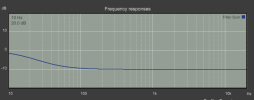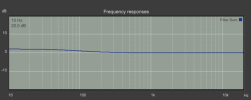- Thread Starter
- #101
This is a pretty well explored subject. It is safe to do so within the xmax of the driver at any frequency response in a sealed speaker, and above the port tuning frequency on a ported speaker. There is no inherent difference between just turning up the volume and applying EQ, you are just shifting the tonal balance of the speaker.
Which arguments / what type of arguments would it take to convince you? The reason it is a bad idea is that below the tuning frequency there is no inherent damping from the cabinet, so your driver will be "flapping in the wind" so to speak. This will quickly lead to your 8361 no longer having a bass driver, which is not ideal.
I think the main reason you're not getting a lot of traction from a science perspective is that the science behind your question is already well known and understood.
A) It already has almost flat response all the way down to the port tuning frequency. The port tuning is around 40hz, so below that you will not get any more meaningful output by EQing it. Above that you can EQ it. It will limit maximum SPL but otherwise be fine.
B) Not for me to say.
View attachment 411622
Thank you for taking the time to reply so helpfully.
In terms of an argument to convince me, it'd be helpful to understand where I'm going so wrong. Perhaps the following example can help us to identify the issue:
(a) Our ported speaker goes flat down to 36Hz
(b) The speaker begins to roll from 36Hz and then rapidly from 30Hz (reaching -6dB at 30Hz)
(c) Our goal is to configure the speaker to extend flat to 30Hz because we listen to music extending this low
(d) If we set a -6dB 40Hz shelving filter using GLM, the response is most usefully boosted from 30-36Hz (the area we most want to target; see attached)
(e) This filter is similar to the +2dB 100Hz shelving filter from around 60-400/500Hz but increasingly boosts below 60Hz, resulting in the speaker extending to 30Hz at 0dB rather than -6dB (see attached)
(f) However, the 36-60Hz range is then boosted above our initial flat response, so we address it using EQ
(g) The <30Hz range is boosted even more but this seems less problematic because of the steep roll off that appears less sensitive to the filter's tilting effect and our music not extending lower than 30Hz (otherwise, perhaps EQ could be applied if our content did extend lower and the tilt was problematic)
(h) Thereafter, the SPL of the speaker is then limited so the <36Hz range places no greater stress on the speaker than the speaker being used some 10dB louder with no EQ (or perhaps more to be safe)
I fail to see the problem because I understand that all we've done is to change the <36Hz range relative to the >36Hz range. How is this so problematically different to the speaker being played some 10dB louder with no EQ applied?
When you state that there "...is no inherent difference between just turning up the volume and applying EQ...", this seems to support what I've proposed. However, your comments thereafter suggests that I may be attempting something else. Unsure where I'm going so wrong or if there's been a miscommunication. Please do put me out of my misery...

